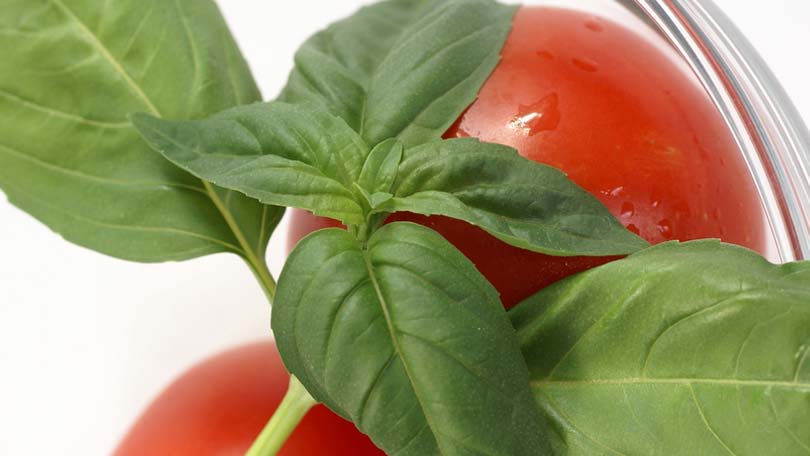
Basil, part of the Ocimum genus, is an aromatic herb in the mint family. Native to warm climates like Africa and India, basils are a large group of herbs in and of themselves – there are over 150 species just in the Ocimum genus, but only around a dozen varieties are relevant to the modern kitchen. Basil has been in use since as far back as the Ancient Greeks and Romans and is one of the most important herbs in Italian cuisine; its use has only become widespread in North America within the last fifty years.
Characteristics
There are a wide variety of basils available on the market today, but the tender, large leafed basils are most commonly used. Sweet basil, or Ocimum basilicum, is probably the most utilized species at the moment – it is native to India and Southeast Asia and is very popular in Europe and the Mediterranean. The plant is small and pretty, growing to around 2’ in height and bearing tiny white flowers and dark green oval leaves. The leaves, which have a crinkly texture and are around an inch long, are the part useful in the kitchen. A few other varieties include Holy basil (Ocimum sanctum), a clove-scented variety held sacred in the Hindu religion; lemon basil, which has a citrusy note to its flavor and aroma; and tree basil, which is popular in India and is used as a bug repellent as well as an herb.
Sweet basil has a fresh, pungent aroma and a green, minty, sometimes peppery flavor with notes of clove. The sweetness of the leaves is lost during the drying process, so fresh basil is recommended when a strong basil flavor is desire in a particular dish.
Common Uses
Basil has drawn loving attention from cooks, authors, and scholars for over two thousand years. One amusing anecdote from the Ancient Greeks explains that the herb was linked to profanity and insanity – growers were recommended to curse and yell while planting the seeds, bringing to mind a phenomenal visual of farmers and gardeners shouting profanities while tending to their gardens. Pliny, Boccaccio, and Keats (amongst many others) all refer to basil in their writings, and the leaves were used as symbols of love and loss in many stories and ballads.
The herb is definitive of Italian cuisine as we now recognize it, but is also utilized frequently in French, Mediterranean, and Southeast Asian cuisines. Basil compliments vegetables such as eggplant, spinach, squash, zucchini, peas, and especially tomato – it is sometimes referred to as the tomato herb. It goes nicely in herb blends, salads, and soups, and is a nice addition to most sauces, stews, and gravies, with Italian pesto being the best example. Basil additionally pairs very well with garlic, parsley, and sage, and these herbs work together to build much of Italian cuisine’s flavor bases. It can also be used with fish, red meat, organ meat, veal, pates, and wild game, or infused into olive oil or vinegars for cooking and bread dipping. Citrusy basils, such as lemon basil, do appear in sweet items such as pastries, custards, sherbets, and teas, and air paired with coconut milk in Southeast Asian cookery.
Use and Storage
Fresh basil is readily available in most mainstream markets and grocery stores. Leaves should be intact, deep green in color, and free of black marks or bleaching. Fresh basil can be frozen and kept for up to one month. Another method recommend layering the leaves in a small jar with salt – the salt will take on a lovely basil perfume which is excellent for cooking.
Dried basil is also easy to obtain but is less flavorful and a much milder aroma than its fresh counterpart. It should be stored in an airtight container out of direct sunlight.
Use It:
- In sauces like pesto for pasta and meat
- To season rice dishes and pilafs
- In soups, stews, and marinades
- Chopped and added to herb salads
- Sautéed with tomato and folded into omelets or quiche
- With veggies like eggplant, zucchini, or squash
- Blended into olive oil for dipping or basting
- Infused into vinegar for salad dressings and cooking
- Paired with tomato and/or tomato based soups and sauces
- To substitute mint in the classic mohito
- With other herbs for herb blends or rubs
- To perfume salt for cooking
- Lightly fried and placed over meats or vegetablesr
Recipe with Basil
Basic Easy Pesto
2 cups packed fresh basil leaves
1 large clove garlic, slivered
1 tablespoon extra virgin olive oil
2 tablespoons pine nuts
4 tablespoons fresh grated parmesan cheese
¼ cup low fat ricotta cheese
½ cup chicken broth
¼ teaspoon fresh ground black pepper
Place all ingredients in a food processor and blend for half a minute. Push contents back towards bottom with a spoon or spatula and blend again until smooth. Use on pasta or for bread dipping.
